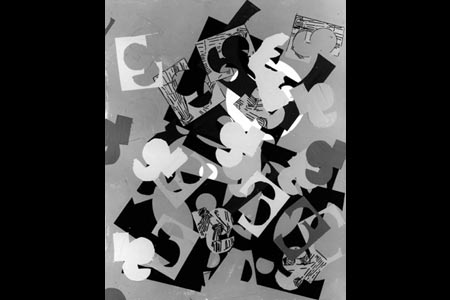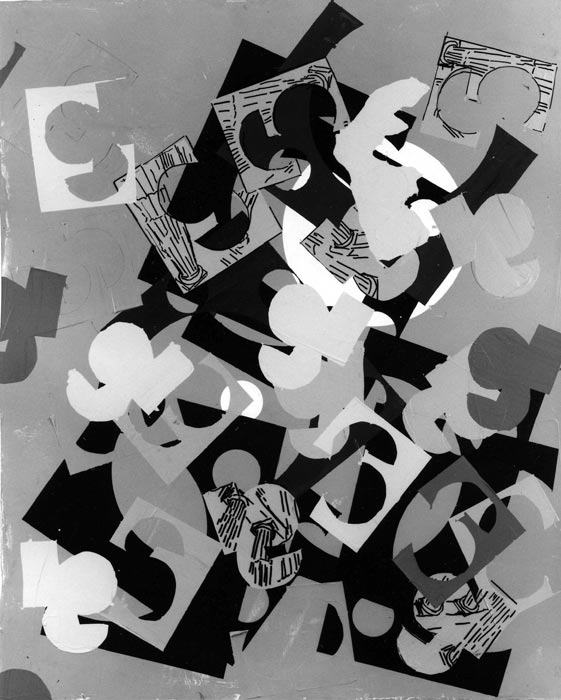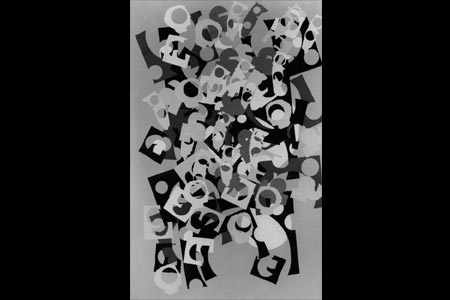The conflict that vexes abstract painting in the late Eighties may be seen as a struggle between the ambitions of high art and those of popular culture. As these polarities collide they are driven further apart; or, at least insofar as Judy Rifka's painting is concerned, they are assimilated one to another.
Judy Rifka's painting is an emblem of this paradox. After all, the present-day subversion of faith in abstraction was promoted, not to say generated, by the community of artists amidst whom Rifka first emerged. Thus, beyond pleasure in painting itself, Rifka's mission has now become that of receding those very signals and signs that had undermined the prestige of abstraction; and, in so-doing, the restoration of our strained belief in transcendence is allowed to take place once again.
Rifka effectively mediates these antinomial fusions, this post-modern alchemy, through an extravagant ostracism of hierarchy. There is her acceptance of Constructivist and Expressionist values as an act of simple faith. This is clear, for example, in her method, the use of thin layers of grayed, milky acrylic paint, laid down adhesive tape-like, one over the other. With careful scrutiny, these layers are visible despite their often close graduation of tint let alone their extreme thinness. Such an examination adds to the pleasure of grasping and, in part, recreating the process of the development of the painting itself. Nothing could be more modernist in nature.
Rifka's commitment to process and discovery, doctrine within Abstract Expressionist practice, is of paramount concern though there is nothing dogmatic or pious about Rifka's use of the method. Playful rapidity and delight in discovery is everywhere evident in her painting.
Such rapid shifts are open to aphorism when glanced by Rifka's quicksilver turn of mind. Small daybooks testify, for example, to the heated production of the History of Sculpture, as the current work is known. They reveal her instrumentalization of the seemingly accidental. "Tremendous amount left to chance," she notes. "Recognize opportunity and Do it." Similarly: "Include imperfections in a deterioration process- Leaving beginnings to chance then shifting them till you see something you've never seen before But that somehow seems to express the moment."
Rifka's modernism, fully realized in the extraordinary abstractions she painted in the Seventies, were countered, this past decade, with ironies about popular culture though, for sure, this ambivalence is, in part, generated by the immense love she feels for the dubious article and kitsch in the first place. Characteristically, symbols of high culture are rendered as diagram, as felt-tip pen drawing of "the art of the ancients,"-the Nike of Samothrace, say, or entablature diagrams illustrating classical orders.
All this would be "high class" were it not for the comic strip-like depiction. Camp sensibility italicizes and capitalizes; it renders exquisite the ambivalence inherent to the banality of the oxymorons uttered or depicted.
For sure, Lichtenstein's classical references must be accounted for. The assimilation of Pop Art to high art represents the pivotal challenge to the authority of pure abstraction as it mediates the most radical inversion of values. For both sides of the equation. Rifka's painting resolves, or at least attempts to, this divergence difference without a distinction. As with Lichtenstein, Rifka's thumbnail spot-illustrations owe much to the advertising agency, to commodity theory, to image repetition and brand-name recognizability-insofar as one is talking about classical monuments; and, of course, to Duchamp. "I do all my drawing on acetate thereby eliminating the ground," she said in the Documenta 7 Catalogue of 1982. Thus is Duchamp's mechanomorphic society invoked. He too set his imagery within an absolute transparent space. All that passes behind the glass elides with transient ground, freeing the painter from the servitude of merely filling it in.
Similarly, Rifka's imagery is derived from a rapid tracing of photographs of the monuments, a virtually off-the-cuff studio resolution that further distances the motif from the cultural significance ofthe original monument, further severs "the sign from the signified," a catchphrase now betraying a certain period enthusiasm. Rifka's references may be to high culture but their depiction flatly asserts the authority of popular culture. Athena Parthenon as take-out coffee cup; Athena Lemnia hairspray; Athena Parthenos insect aerosol; Corinthian Crackerjacks.
Originally, Rifka worked primarily in oils, eventually settling on acrylics. "The drying time of oils is so horrible and so No Working in Layers." These layers continue with profligate variety in the current paintings. The cutout, silhouetted in template, is snipped from ordinary household shelving paper. Primary shape, secondary shape, negative/positive interplay is achieved through inspired variation flat, reversed, inverted and so on. The application of the system suggests a musical parallel, the Bach Two-or-Three-Part Invention, for example: first theme, second theme, inversion of the theme, ornamentation of the theme, inversion of the ornament, etc.
This hyperactive investigation asserts Cubo-Futurist origins. The present paintings recall spiraling permutations that occur in etchings by Jacques Villon, the Chessboard, say, or the Lamps. Nor is late-Futurist typography and photography under Mussolini a farfetched comparison. Rifka also works with images of a classical origin. This source came to be abused by the Fascists for a propaganda that asserted the superiority of a mythic Italian past by way of muffling outrage against its claims to entitlement in the present.
Rifka's free use of imagery, be it classical or popular, undermines the pretended refrigeration, the purity of high modernist abstraction. "Why should you have to leave out the drawing just because you made an abstraction?" she asks. "It's about letting in another bit of information."
"Why are the works so gray?" I ask. "I'm good at drawing," Rifka answers. "The longer I can hold out on the color, the more I can demand of the painting."
Still, I take color to be the ground zero of painting. Rifka astonishes by her blithe astuteness, her cool:
"Color," she says, "It's Red, Yellow, Blue, with black and white. It's formulas. You take two strong complementaries and add black and white. It's good. It's formulas."
II
A dutiful, correct daughter, Judy Rifka studies as Hunter College. After two years she goes to England on summer holiday. She paints at sthe Chelsea Art School. She becomes, as John Lennon said, an artist in eher own write. She feels at home in Swinging London, as that distant scene is called. A friend of Donovan and Phil Ochs, she inds herself at the center of musical developments of considerable interest.
Two years later Rifka returns to New York City and enrolls at the Studio School. The sentimental pieties of the school appeal, its mythology of studio drudgery. Modernism is dogma, the authority of Cezanne's form, of Giacometti's pint-topoint in space, of Hofmann's Push and Pull, all are studied in prim ernestness. Rifka loves it Young painters always do.


